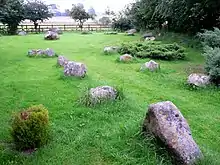
Sarsen stones are silicified sandstone blocks found in quantity in Southern England on Salisbury Plain and the Marlborough Downs in Wiltshire; in Kent; and in smaller quantities in Berkshire, Essex, Oxfordshire, Dorset, and Hampshire.
Geology
Sarsen stones are the post-glacial[1] remains of a cap of Cenozoic silcrete that once covered much of southern England – a dense, hard rock created from sand bound by a silica cement, making it a kind of silicified sandstone. This is thought to have formed during Neogene to Quaternary weathering by the silicification of Upper Paleocene Lambeth Group sediments, resulting from acid leaching.[2]
Etymology
The word "sarsen" is a shortening of "Saracen stone" which arose in the Wiltshire dialect. In the Middle Ages, "Saracen" was a common name for Muslims, and came by extension to be used for anything regarded as non-Christian, whether Muslim or pagan in contrast to Christianity.[3]
Human uses
The builders of Stonehenge used these stones for the Heel Stone and sarsen circle uprights.[4][5] Avebury and many other megalithic monuments in southern England are also built with sarsen stones.[6]
Fire and in later times explosives were sometimes employed to break the stone into pieces of a suitable size for use in construction. Sarsen is not an ideal building material, however. William Stukeley wrote that sarsen is "always moist and dewy in winter which proves damp and unwholesome, and rots the furniture".[7][8] In the case of Avebury, the investors who backed a scheme to recycle the stone were bankrupted when the houses they built proved to be unsaleable and also prone to burning down. However, despite these problems, sarsen remained highly prized for its durability, being a favoured material for steps and kerb stones.
See also
References
- ↑ Small, R.J.; Clark, M.J.; Lewin, J. (January 1970). "The periglacial rock-stream at Clatford Bottom, Marlborough Downs, Wiltshire". Proceedings of the Geologists' Association. 81 (1): 87–98. doi:10.1016/s0016-7878(70)80037-2.
- ↑ Stewart Ullyot, J.; Nash, D.J.; Whiteman, C.A.; Mortimore, R.N. (2004). "Distribution, petrology and mode of development of silcretes (sarsens and puddingstones) on the eastern South Downs, UK". Earth Surface Processes and Landforms. 29 (12). Bibcode:2004ESPL...29.1509U. doi:10.1002/esp.1136.
- ↑ Stevens, Frank (1926). "The Lithology of Stonehenge". Stonehenge Today & Yesterday. London: HMSO. OCLC 1167089420.
- ↑ Bruce Bedlam. "The stones of Stonehenge".
- ↑ Steven Morris (14 April 2020). "Like Lego: rare photo shows Stonehenge construction technique". The Guardian.
- ↑ "Stone ring of Avebury". Places of Peace and Power.
- ↑ William Stukely (1743), Palaeographia Britannica, vol. 1
- ↑ Edward Herbert Stone (1924), The Stones of Stonehenge, p. 54
External links
![]() Media related to Sarsen stones at Wikimedia Commons
Media related to Sarsen stones at Wikimedia Commons
- Photo of Sarsens on Fyfield Down, Wiltshire
- King, N. E. (1968). "The Kennet Valley Sarsen Industry". Wiltshire Archaeological and Natural History Magazine. 63: 83–93. ISSN 0262-6608. OCLC 557553197. Retrieved 23 November 2016.
